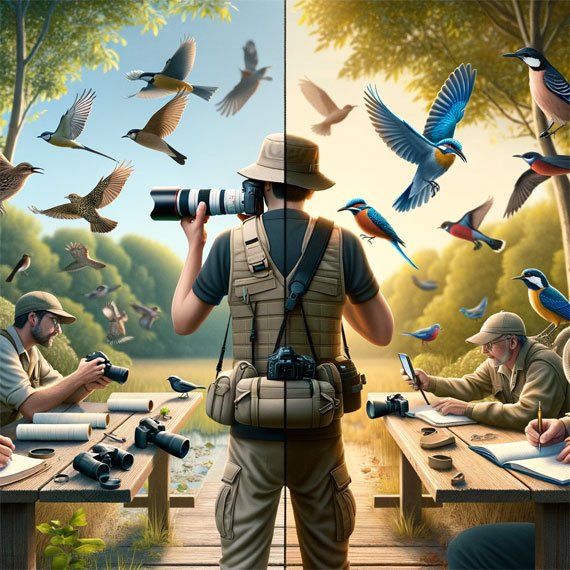Bird photographers and birders share a common passion for avian species, yet their approaches and motivations can vary significantly. Both groups contribute uniquely to the appreciation, understanding, and conservation of birds, but they do so in ways that reflect their distinct interests and goals. Let’s delve into the differences and similarities between bird photographers and birders.
Relevant reminder: Winter ends on March 19 in the Northern Hemisphere along with the deal on these Photography Adventure Cheat Sheets which include one on photographing birds in flight.
Similarities
- Shared Passion for Birds: At the core, both bird photographers and birders have a profound appreciation for birds and their natural habitats. Their activities are often driven by a love for wildlife and a desire to be close to nature.
- Conservation Awareness: Both groups often engage in and promote conservation efforts. Their interest in birds leads to a greater awareness of the importance of habitat preservation and the threats faced by various species.
- Field Skills: Birders and bird photographers develop keen observation skills, learning to identify birds by sight and sound. Both must also understand avian behaviors and habitats to successfully locate and observe their subjects.
- Community Engagement: Both groups tend to be part of larger communities, sharing their experiences, sightings, and photographs. They participate in forums, clubs, and social media platforms, contributing to a collective knowledge base and fostering a shared enthusiasm for avian life.
Differences
- Primary Motivation: Bird photographers are primarily focused on capturing images of birds. Their success is often measured by the quality, rarity, or artistic value of their photographs. Birders, on the other hand, may be more interested in observing and documenting bird species, with their achievements often related to the number of species identified or the observation of rare birds.
- Equipment and Investment: Bird photography typically requires significant investment in specialized equipment, such as high-quality cameras, telephoto lenses, and sometimes even hides or camouflage gear. Birders might require less equipment, often relying on binoculars and field guides, though some may also use high-end optics.
- Approach and Time Spent: Photographers may spend considerable time waiting for the perfect shot, often focusing on a single location or individual. Birders tend to be more mobile, moving to different locations to observe as many species as possible.
- Interaction with Subjects: Photographers need to get close enough for a good shot without disturbing the bird, requiring a balance between proximity and respect for the bird’s comfort zone. Birders, especially those who are listers, might prioritize identification over close interaction, often using binoculars or scopes to minimize disturbance.
Potential Rivalry
Despite their shared passions, there can be moments of friction between bird photographers and birders, stemming from their different objectives and methods. Bird photographers, in their quest for the perfect shot, might inadvertently disrupt a birder’s observation or stay longer at a sighting, potentially affecting the birders’ ability to spot and identify different species. Conversely, large groups of birders moving through an area can disturb wildlife, making it challenging for photographers to capture images of birds in their natural and undisturbed state.
Some birders might view photographers as more intrusive, especially when they use playback sounds to attract birds or get closer to nests than recommended guidelines suggest. On the other hand, photographers might feel that birders do not always appreciate the effort and patience required to obtain impactful wildlife photographs.
However, these tensions are not universal and often arise from misunderstandings or the actions of a few rather than the groups as a whole. Many birders and photographers work together harmoniously, recognizing that they share more similarities than differences and that respectful dialogue and mutual understanding can help mitigate any rivalry. By focusing on their common goals and the greater purpose of bird conservation, both communities can foster a more collaborative and supportive relationship.
Convergence for Conservation
Despite their differences, both bird photographers and birders play essential roles in conservation. Photographers often capture images that inspire public interest and empathy for avian conservation. Birders contribute to citizen science projects like eBird, providing valuable data that helps in the study and protection of bird populations.
In conclusion, while bird photographers and birders might embark on their outdoor adventures with different intentions and tools, they share a fundamental connection through their appreciation and advocacy for birds. By understanding both the common ground and the unique perspectives of each group, we can better appreciate the diverse ways people engage with and work to protect the avian world.
For Further Training:
For help remembering the camera settings for difficult situations such as birds in flight, a set of Photography Adventure Cheat Sheets are designed to help. They are currently 80% off for a winter sale which ends soon if you want to check them out.
The perfect companion for any photographer. Print one out whenever you need it. Whether you’re going on vacation or seeking out a specific photography adventure, these cheat sheets can provide you with the knowledge and inspiration you need to create your best work yet.
Only 1 day left: The Photography Adventure Cheat Sheets Winter Sale
Like This Article?
Don't Miss The Next One!
Join over 100,000 photographers of all experience levels who receive our free photography tips and articles to stay current:








Leave a Reply